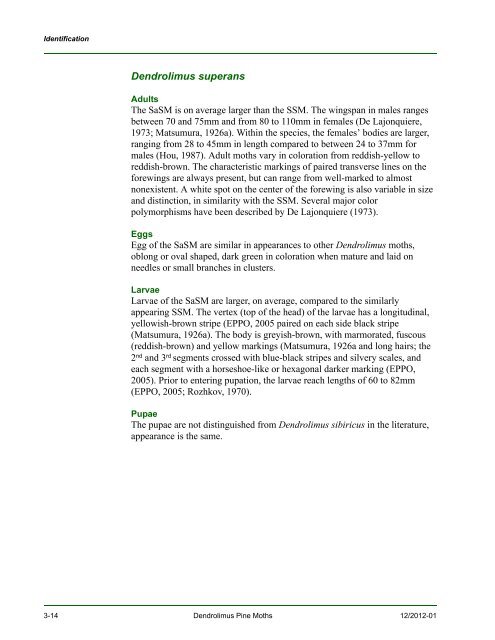New Pest Response Guidelines - aphis - US Department of Agriculture
New Pest Response Guidelines - aphis - US Department of Agriculture
New Pest Response Guidelines - aphis - US Department of Agriculture
Create successful ePaper yourself
Turn your PDF publications into a flip-book with our unique Google optimized e-Paper software.
Identification<br />
Dendrolimus superans<br />
Adults<br />
The SaSM is on average larger than the SSM. The wingspan in males ranges<br />
between 70 and 75mm and from 80 to 110mm in females (De Lajonquiere,<br />
1973; Matsumura, 1926a). Within the species, the females’ bodies are larger,<br />
ranging from 28 to 45mm in length compared to between 24 to 37mm for<br />
males (Hou, 1987). Adult moths vary in coloration from reddish-yellow to<br />
reddish-brown. The characteristic markings <strong>of</strong> paired transverse lines on the<br />
forewings are always present, but can range from well-marked to almost<br />
nonexistent. A white spot on the center <strong>of</strong> the forewing is also variable in size<br />
and distinction, in similarity with the SSM. Several major color<br />
polymorphisms have been described by De Lajonquiere (1973).<br />
Eggs<br />
Egg <strong>of</strong> the SaSM are similar in appearances to other Dendrolimus moths,<br />
oblong or oval shaped, dark green in coloration when mature and laid on<br />
needles or small branches in clusters.<br />
Larvae<br />
Larvae <strong>of</strong> the SaSM are larger, on average, compared to the similarly<br />
appearing SSM. The vertex (top <strong>of</strong> the head) <strong>of</strong> the larvae has a longitudinal,<br />
yellowish-brown stripe (EPPO, 2005 paired on each side black stripe<br />
(Matsumura, 1926a). The body is greyish-brown, with marmorated, fuscous<br />
(reddish-brown) and yellow markings (Matsumura, 1926a and long hairs; the<br />
2 nd and 3 rd segments crossed with blue-black stripes and silvery scales, and<br />
each segment with a horseshoe-like or hexagonal darker marking (EPPO,<br />
2005). Prior to entering pupation, the larvae reach lengths <strong>of</strong> 60 to 82mm<br />
(EPPO, 2005; Rozhkov, 1970).<br />
Pupae<br />
The pupae are not distinguished from Dendrolimus sibiricus in the literature,<br />
appearance is the same.<br />
3-14 Dendrolimus Pine Moths 12/2012-01

















